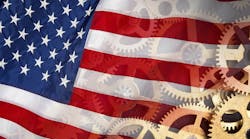The COVID-19 pandemic has created a once-in-a-generation challenge to ramp up America’s industrial manufacturing with no advanced notice.
In some ways, we have met the moment, collaborating in real time to produce tens of thousands of ventilators under the Defense Production Act. But in other ways, the pandemic has served as an alarm bell in areas where we have not been ready enough.
For example, we allowed manufacturers to offshore the production of critical emergency equipment, namely N95 masks, gowns and gloves. American companies let that business go to cut costs, but we ended up cutting back on our independence and preparedness, too. And the need to store the vaccine in ultra-cold conditions has created a backlog in freezer orders, exposing how manufacturing limitations can slow our ability to recover from major disasters.
We have tapped into only a small fraction of our industrial capacity. We have left a lot of our players on the sidelines. And in a crisis like this—and in the increasingly uncertain and challenging future—we need everyone on the field.
We need a national virtual warehouse to store electronic designs and manufacturing instructions for critical emergency equipment. We need far better mapping of supply chains so we can identify where shortages will have a cascading impact. We need a “manufacturing guard” — like the National Guard — a team of experts that would tackle manufacturing challenges in times like this.
We also need what the industry calls “warm base” contracts for the most critical disaster-response equipment. This is when the government pays a premium to have the equipment manufactured domestically, and to keep extra, dormant factory lines in working order so that production can be ramped up quickly.
Plenty of people have called for the government to organize all of this. And in an early positive sign, President Joe Biden has ordered use of the Defense Production Act to boost the supply of masks, testing kits and vaccine equipment. Perhaps a more aggressive posture by the government is at hand. But we all know the divisions in this country and the history of federal bureaucracy. Our nation’s leading manufacturers would be wise to push forward now and see if the government catches up.
Here are some things our industry can do on our own initiative:
Move our designs into our own digital warehouse, one by one. Even without an overarching government mandate, manufacturers are increasingly sharing open-source designs that can be used to make critical equipment in an emergency. The creation of digital supply chains allows products to be made at any location worldwide where a factory can be constructed. This is not just a failsafe for worst-case scenarios—it’s a way of creating products near their destinations. Shipping over land, sea and air will be supplemented and often supplanted by the ability to share designs instantly with faraway factories in coming decades.
Dynamically monitor our supply chains. With digital surveillance and mapping, manufacturers can be alerted about a problem in India that could gum up their production in Dubuque, Iowa. While government assistance with information-sharing and standardization would be welcome, forward-thinking businesses can develop early-warning systems for their own supply chains now, so they can pivot smoothly to Plan B if necessary.
Inject fresh talent in the industrial workforce. The graying of our workforce has exposed inadequate efforts to recruit and train the young people vital to our future. Let’s face it: We’ve got a PR problem. There’s a stereotype that manufacturing is dirty, dark and dangerous when, in fact, it can be modern, fun and high-tech. When you say “factory” to young Americans, very few would imagine our clean, digitally advanced production floor at Fast Radius. They’re still thinking of steel mills.
We can take these significant steps right now to assert a leading role for the United States in manufacturing. Companies in the know must spread that knowledge to others, to bring up the whole industry. That way, even if our government is late to the game, at least we’ll still be players.
John Nanry is co-founder and chief manufacturing officer of Fast Radius, a Chicago-based manufacturing technology company that runs one of the most advanced “lighthouse” factories in the world.




